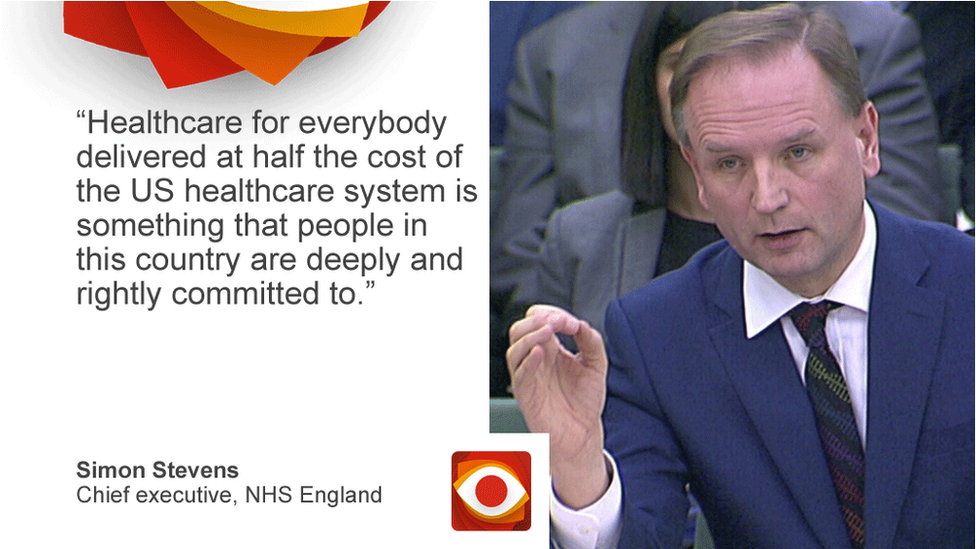Reality Check: Does UK spend half as much on health as US?
- Published

The claim: The NHS costs half as much as the US health system, and cares for the whole population.
Reality Check verdict: If you look at every penny spent on health by anyone in the country, then the UK spends about half as much on health as the US does. But if you compare the amount spent on the NHS with the amount spent by the US government on public healthcare, the difference is much smaller.
US President Donald Trump has caused a stir by tweeting his criticisms of the UK's universal healthcare, describing it as a system that is "going broke and not working".
NHS England boss Simon Stevens responded that "healthcare for everybody delivered at half the cost of the US healthcare system is something that people in this country are deeply and rightly committed to".
In the UK, healthcare is universal, while in the States there are 28 million people who are not covered by public or private insurance.
But does the NHS really cost half as much?
If you look at all healthcare spending, external, including treatment funded privately by individuals, the US spent 17.2% of its GDP on healthcare in 2016, compared with 9.7% in the UK.

In pounds per head, that's £2,892 on healthcare for every person in the UK and £7,617 per person in the US.
So as a proportion of the value of the goods and services produced by all sectors of the economy the UK spends a bit more than half what the US spends, and in spending per head it's a bit less than half.

The difficulty is, when it comes to comparing healthcare in different countries, you're never exactly comparing like for like.
Almost all health systems are a mixture of public and private - it's the ratio that varies.
In the UK, the public health system can be accessed by all permanent residents, is mostly free at the point of use and is almost entirely paid for through taxation.
Americans are far more likely to rely on private insurance to fund their healthcare since accessing public healthcare is dependent on your income.
Many European countries, meanwhile, have a social insurance system where insurance contributions are mandatory. This doesn't fall under general taxation but is not dissimilar from paying National Insurance in the UK and means everyone can access healthcare.
Allow X content?
This article contains content provided by X. We ask for your permission before anything is loaded, as they may be using cookies and other technologies. You may want to read X’s cookie policy, external and privacy policy, external before accepting. To view this content choose ‘accept and continue’.
But even if you look only at public money spent on health, the US government's spending on healthcare still outstrips UK government spending, both in terms of the proportion of its GDP (the way we normally measure the size of a country's economy) and in terms of how much it spends per head.
Almost half of US health spending still comes from public money including general taxation - although it's the only country in the G7 to pay publicly for less than 50% of all healthcare that's provided.
What this doesn't tell you, though, is how effective a healthcare system is, and this seems to be what Mr Stevens was getting at.
Life expectancy
The UK government spends less on health and provides a universal service where every permanent resident can access care.
In the US, even after major changes to the system, there are 28 million people who don't have any private or public insurance.
The Organisation for Economic Co-operation and Development (OECD) says life expectancy in the United States is slightly lower than average, despite very high levels of health spending.
In many cases, the more a country spends on healthcare per person, the longer its citizens' life expectancy.
Gun crime and opioids
But while the US spends more per person than the UK on healthcare, in 2014, average life expectancy at birth in the USA was 78.8, compared with 81.4 in the UK according to the Office for National Statistics (ONS).
"Japan spent the fifth most per person on healthcare and had the highest life expectancy, while Italy spent the least per person and had the second highest life expectancy," the ONS's statisticians point out.
Life expectancy is a helpful, although not perfect indicator of the quality of a nation's healthcare.
It is affected by other complicated social factors, such as diet and the prevalence of smoking.
Americans consume more tobacco per head than Britons and are more likely to be overweight or obese.
Opioid deaths and gun crime, external also affect average American life expectancy.
Safety, affordability and efficiency
In the summer, US think tank the Commonwealth Fund ranked the NHS the number one health system in a comparison of 11 countries for safety, affordability and efficiency. It did less well when it came to cancer survival
The US was ranked last out of the 11 countries.
The American health system came off badly in comparison when it came to infant mortality, life expectancy, and preventable deaths, but did relatively better on cancer, heart attack and stroke survival.
Meanwhile, the UK's cancer survival rates, external have historically been below the European average, although they are improving for certain cancers.
The UK has fewer doctors, nurses and hospital beds than the OECD average.


- Published5 February 2018
